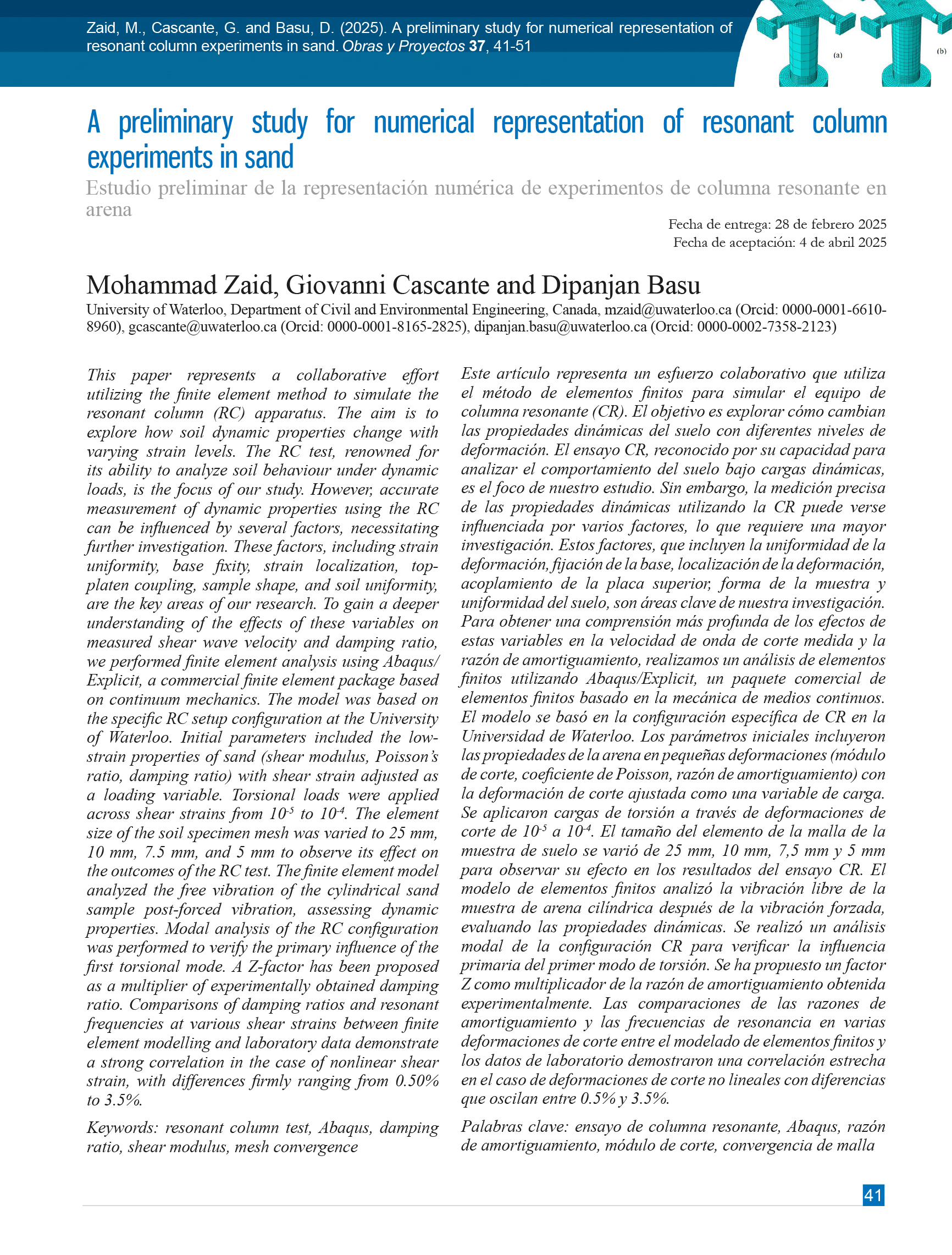A preliminary study for numerical representation of resonant column experiments in sand
DOI:
https://doi.org/10.21703/0718-2813.2025.37.3235Keywords:
Resonant column test, Abaqus, Damping ratio, Shear modulus, Mesh convergenceAbstract
This paper represents a collaborative effort utilizing the finite element method to simulate the resonant column (RC) apparatus. The aim is to explore how soil dynamic properties change with varying strain levels. The RC test, renowned for its ability to analyze soil behaviour under dynamic loads, is the focus of our study. However, accurate measurement of dynamic properties using the RC can be influenced by several factors, necessitating further investigation. These factors, including strain uniformity, base fixity, strain localization, topplaten coupling, sample shape, and soil uniformity, are the key areas of our research. To gain a deeper understanding of the effects of these variables on measured shear wave velocity and damping ratio, we performed finite element analysis using Abaqus/Explicit, a commercial finite element package based on continuum mechanics. The model was based on the specific RC setup configuration at the University of Waterloo. Initial parameters included the lowstrain properties of sand (shear modulus, Poisson’s ratio, damping ratio) with shear strain adjusted as a loading variable. Torsional loads were applied across shear strains from 10-5 to 10-4. The element size of the soil specimen mesh was varied to 25 mm, 10 mm, 7.5 mm, and 5 mm to observe its effect on the outcomes of the RC test. The finite element model analyzed the free vibration of the cylindrical sand sample post-forced vibration, assessing dynamic properties. Modal analysis of the RC configuration was performed to verify the primary influence of the first torsional mode. A Z-factor has been proposed as a multiplier of experimentally obtained damping ratio. Comparisons of damping ratios and resonant frequencies at various shear strains between finite element modelling and laboratory data demonstrate a strong correlation in the case of nonlinear shear strain, with differences firmly ranging from 0.50% to 3.5%.
References
Ashmawy, A.K. and Drnevich, V.P. (1994). A general dynamic model for the resonant column/quasi-static torsional shear apparatus. Geotechnical Testing Journal 17(3), 337-348.
ASTM D4015 (2007). Standard test methods for modulus and damping of soils by resonant-column method. ASTM International, West Conshohocken, PA, USA.
Avramidis, A.S. and Saxena, S.K. (1990). The modified “stiffened” Drnevich resonant column apparatus. Soils and Foundations 30(3), 53-68.
Bae, Y.S. (2008). The effects of end platens on effective stresses in resonant column (RC) specimens during consolidation. Journal of the Earthquake Engineering Society of Korea 12(1), 29-42.
Bui, M.T., Priest, J.A. and Clayton, C.R.I. (2019). A new calibration technique to improve data reduction for Stokoe resonant column test. First Vietnam Symposium on Advances in Offshore Engineering: Energy and Geotechnics, M. Randolph et al. (eds.), Springer, Singapore, 43-48.
Cascante, G., Santamarina, C. and Yassir, N. (1998). Flexural excitation in a standard torsional-resonant column device. Canadian Geotechnical Journal 35(3), 478-490.
Cascante, G., Vanderkooy, J. and Chung, W. (2003). Difference between current and voltage measurements in resonant-column testing. Canadian Geotechnical Journal 40(4), 806-820.
Cherian, A.C. and Kumar, J. (2016). Effects of vibration cycles on shear modulus and damping of sand using resonant column tests. Journal of Geotechnical and Geoenvironmental Engineering 142(12), 06016015.
Cherian, A.C. and Kumar, J. (2017). Effect of vibration cycles batches on shear modulus and damping of dry sand. Journal of Geotechnical and Geoenvironmental Engineering 143(9), 06017007.
Cheng, Z., and Leong, E.C. (2016). Finite element simulations of wave propagation in soils using a viscoelastic model. Soil Dynamics and Earthquake Engineering 88, 207-214.
Clayton, C.R.I., Priest, J.A., Bui, M., Zervos, A. and Kim, S.G. (2009). The Stokoe resonant column apparatus: effects of stiffness, mass and specimen fixity. Géotechnique 59(5), 429-437.
d’Onofrio, A., Silvestri, F. and Vinale, F. (1999). A new torsional shear device. Geotechnical Testing Journal 22(2), 107-117.
Drnevich, V.P. (1978). Resonant-column testing—Problems and solutions. Dynamic Geotechnical Testing. M.L. Silver and D. Tiedemann (eds.). ASTM International, STP 654, 384-398.
Hardin, B. and Music, J. (1965). Apparatus for vibration of soil specimens during the triaxial test. Instruments and Apparatus for Soil and Rock Mechanics. ASTM International, SPT 392, 55-74 Hardin, B.O. and Richart, F.E. (1963). Elastic wave velocities in granular soils. Journal of the Soil Mechanics and Foundations Division 89(1), 33-65.
Khan, Z., El Naggar, M.H. and Cascante, G. (2011). Frequency dependent dynamic properties from resonant column and cyclic triaxial tests. Journal of the Franklin Institute 348(7), 1363-1376.
Menq, F.Y., and Stokoe, K. (2003). Linear dynamic properties of sandy and gravelly soils from large-scale resonant tests. Third International Symposium on Deformation Characteristics of Geomaterials, H. Di Benedeto et al. (eds.), Lyon, France, 63-71.
Stokoe, K.H., Isenhower, W.M. and Hsu, J.R. (1980). Dynamic properties of offshore silty samples. Offshore Technology Conference, Houston, USA, OTC-3771.
Stoll, R.D. (1985). Marine sediment acoustics. The Journal of the Acoustical Society of America 77(5), 1789-1799.
Sultaniya, A.K., Clayton, C.R.I., Priest, J.A., Nayan, K.A.M. and Taha, M. (2010). Assessing cross anisotropy of small-strain stiffness using the resonant column apparatus. Fifth International Conferences on Recent Advances in Geotechnical Earthquake Engineering and Soil Dynamics, San Diego, USA, paper 1.14b.

Downloads
Published
Issue
Section
License
Copyright (c) 2025 Universidad Católica de la Santísima Concepción

This work is licensed under a Creative Commons Attribution-NonCommercial 4.0 International License.







